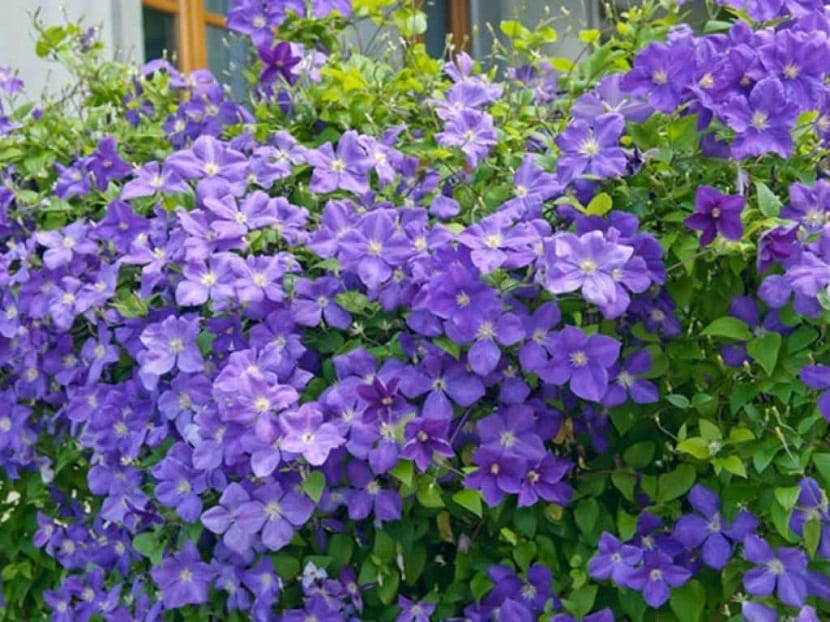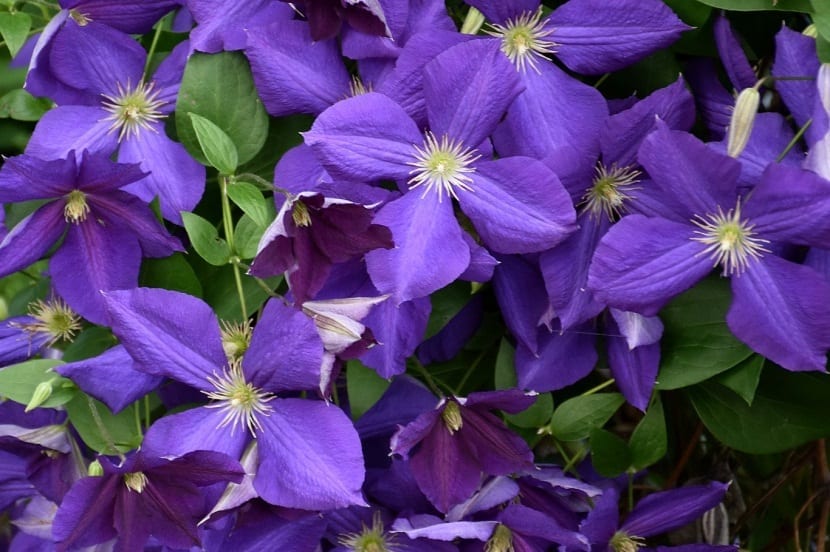
The Clematis Jackmanii es of the clematis varieties that are most cultivated in all temperate zones of the earth; This beautiful deciduous hybrid climber that can reach up to four meters in height, is part of the Ranunculaceae family, which is made up of approximately 250 species.
The plant known as Joy of travelers it often adorns the roads of the English countryside.
Features

Its stems are long, bony and slender and its slightly lanceolate, deep green leaves are arranged in pairs that they serve to support flowers of various sizes with four purple petals bordering a crown of yellow stamens.
They develop from late winter to late summer where it multiplies by mugrones, while in spring by cutting. After flowering, bunches of fluffy walnuts emerge with showy pods that contain them. Though it has no roots to hold on to, its extensive petioles have the property of curling around the branches.
The vine comes from the Jackman nurseries in Surrey in the United Kingdom where it is believed to have emerged in 1858 as a result of a cross made by George Jackman between Clematis laguninosa and Clematis viticella.
To grow in full sun or semi-shade, this genus requires moderate temperatures of between 15-25ºC. Also from a well-drained limestone soil with abundant organic matter such as mulch, compost, peat, worm castings or manure and sand for drainage.
It can be replanted in spring or autumn and its conservation depends on the treatment you give it, it is recommended that you water it always, fertilize annually with a mineral fertilizer to help its flowering and which is late in summer. Finally you have to prune it lightly to regulate its growth, do it preferably with gloves, you will prevent skin irritations.
Diseases and pests
Clematis is susceptible to various pests produced by the butterfly, moth, aphid, arachnoid mite or slugs, and also to diseases like mold which is notorious in the hot summer months in the southern regions.
The aging produced by the spores of the fungi that inhabit the soil clog the blood vessels of the shoots, destroying their metabolism and wilting them. Likewise, the yellow mosaic, ascochitis or spots, gray rot and extinction of the leaves, are motivated by the limitation of photosynthesis, the appearance of mushrooms or the use of inappropriate fertilizers.
It should be noted that this plant, unlike other species, in good conditions can live up to 50 years, so it is important that you detect the infection or invasive agent in its initial stage, to take the corresponding forecasts with the products offered by the market to cure it more easily and quickly.
In principle, spread a solution on the ground around the clematis (20 grams per 10 liters of water) of mint, wormwood and manure, pour the preparation into a sprayer and make sure that their shoots are completely wet with the ammonia they release, you will be amazed how the parasites causing the infection are immediately eliminated.

Moreover, always kill weeds on the ground removing the diseased parts, they are a source of contagion for the nearby plants that you have in your yard. Also, if you regularly change the bushes of the pots, you protect them from fungi (avoid the plastic ones and black ones), place them in the sun and take care of their roots, since they should not have contact with the hot soil.
Help yourself with a metal or plastic cloth since by not staying upright by themselves need support to hold on and develop. Although for some vines it is not mandatory because by nature they spread on the ground without any problem.
This exotic evergreen or deciduous climber has varieties with purple, white, red, pink and blue flowers in a starry shape that are ideal to decorate your gardens or terraces at home or office. In the next season organize a splendid garden with Clematis Jackmanii flowers, creatively covering with them the surface of a wall, wall, column, fence or gazebo.
You will enjoy the visual charm of its delicate nuances and you will help preserve a precious plant species.